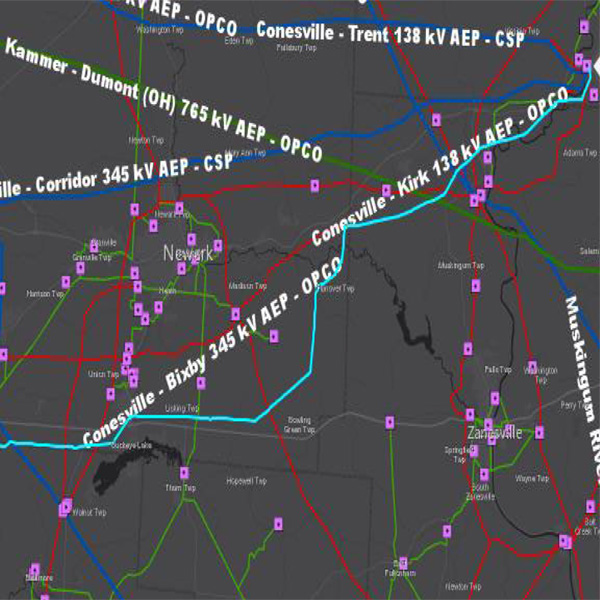
Planning Committee
Interconnection Process Subcommittee
PJM is proposing the creation of a new subcommittee to continue discussions of interconnection process changes after work in the Interconnection Process Reform Task Force (IPRTF) finishes.
Jason Connell, PJM director of infrastructure planning, provided a first read of the draft charter of the Interconnection Process Subcommittee (IPS) at last week’s Planning Committee meeting. Connell presented the concept of the new subcommittee at the March 8 PC meeting. (See “Interconnection Subcommittee Initiative,” PJM PC/TEAC Briefs: March 8, 2022.)
Connell said PJM staff have continued internal discussions and talks with stakeholders about creating the new subcommittee to carry on discussions on additional interconnection issues identified in the IPRTF. He said the purpose of the IPS is to provide a stakeholder forum to “investigate and resolve specific issues related to the interconnection process and associated agreements, governing documents and manuals.”
Discussion topics featured in the charter include:
- education on current and future interconnection processes and agreements with clarifications around implementation;
- development of improvements of interconnection process rules in the tariff and related PJM manuals;
- encouraging continued dialogue between stakeholders and PJM on best business practices and coordination with neighboring RTO/ISOs on interconnection.
Connell said PJM fields many questions from developers on how the RTO plans to implement aspects of the interconnection process not explicitly described in the manuals and the tariff. He said PJM wants to use the subcommittee as an “incubator” for discussions on complex interconnection issues and to come up with solutions.
The IPS will report to the PC, Connell said, but some of the issues to be discussed may impact operations and markets, requiring reports to the Market Implementation Committee and the Operating Committee. Connell said PJM intends to begin holding meetings of the new subcommittee by June and establish a near-term agenda if endorsed by stakeholders.
“PJM was very much in favor of doing this, as it has seen the benefits of the discussions that have taken place at the IPRTF over several months and the consensus that we’ve been able to build around the Planning Committee’s endorsed package,” Connell said. “We want to continue that dialogue in order to continually refine and improve the interconnection process to facilitate the renewable transition.”
Ken Foladare of Tangibl Group said his company supports the new subcommittee and the concept of having an “ongoing discussion” of the interconnection process. Many renewable customers will want process changes and improvements “quite frequently,” he said, asking if PJM could implement a process where proposed changes are considered annually in one batch instead of piecemeal because the number of changes “could get a bit difficult to manage.”
Connell said PJM would have to “look at the magnitude of the changes” proposed and “batch them appropriately” depending on their urgency.
“We certainly don’t want to overwhelm the standing committees with monthly changes as we’re moving through,” Connell said.
Sharon Midgley of Exelon said it “makes a lot of sense” to have the new venue for interconnection discussions. She said Exelon wondered how the subcommittee will “work mechanically” and how issues will be prioritized.
Dave Anders, director of stakeholder affairs for PJM, said the IPS will operate similarly to other subcommittees that report to a standing committee, pointing to the Cost Development Subcommittee as an example. He said Manual 34 stipulates that subcommittees are allowed to take on work that’s within the charter of the group.
Any disagreement among stakeholders in the group should be addressed by the PC, Anders said.
Midgley said she would like to see some expectation language included in the charter so that stakeholders “know the bounds and the rules under which we’re engaged” in the committee.
RSCS Charter
Monica Burkett, PJM senior lead knowledge management consultant, provided a first read of proposed changes to the charter of the Reliability Standards and Compliance Subcommittee (RSCS).
Burkett said the RTO is looking to improve discussions and find more efficiencies in the RSCS, including maintaining up-to-date information on issues. She said several changes are being proposed to improve what compliance information is provided and shared with stakeholders in the subcommittee.
Burkett said the charter updates include “simple tweaks” to language for clarification.
One item proposed to be removed from the charter language is the development of a list of functions performed by other registered entities “in support of PJM compliance.” Burkett said the list of functions are reviewed at the RSCS, but they are never developed by the subcommittee.
Under the responsibilities section of the charter, PJM removed the item “cooperate with PJM with regard to data requests and submittals related to NERC and regional reliability standards” and inserted “allow for exchange of best practices and discussions surrounding upcoming data requests related to NERC and regional reliability standards.”
The committee will be asked to vote on the charter at next month’s PC and OC meetings.
Manual 21A ELCC Changes Endorsed
Stakeholders endorsed an issue charge and manual revisions related to an effective load-carrying capability (ELCC) model run timing update and other changes to reflect the continuation of the current method of providing unit-specific backcasts only as requested. The endorsement received 182 votes in support (97.3%) and 182 votes (97.3%) favoring the changes over the status quo.
Joshua Bruno, senior analyst in PJM’s resource adequacy planning department, reviewed the changes to Manual 21A: Determination of Accredited UCAP Using Effective Load Carrying Capability Analysis, along with the problem statement and issue charge.
PJM rules allow voluntary submission of unit-specific wind and solar parameters for development of backcasts for newer resources, Bruno said, but current manual language has an expiration date of March 1 for voluntary submissions. The submission of unit-specific parameters for all wind and solar is mandatory after the expiration date.
The alternative method is to use a zonal backcast, Bruno said, which PJM has found to be an “adequate” process.
The quick fix called for removing the March 1 expiration date, which would allow PJM to continue the current practice in which newer resources can elect to submit the unit-specific data or use the zonal backcast.
Bruno said another change in the proposal would have the 2025/26 Base Residual Auction use the December 2022 ELCC run instead of the older July 2022 run. He said the change would allow for the most recent data to be used when calculating the accredited unforced capacity (UCAP) for the 2025/26 BRA, with the July 2022 run to be removed from the schedule.
The issue charge and manual revisions now go to the April 27 Markets and Reliability Committee meeting for a first read.
Manual 14F Revisions Endorsed
Stakeholders unanimously endorsed revisions to Manual 14F: Competitive Planning Process related to the biennial review.
Joseph Hay of PJM’s infrastructure coordination department reviewed the revisions that featured two main changes to the manual.
First, the critical energy/electric infrastructure information (CEII) in Manual 14F was referenced over to Manual 14B because the latter is the source document for PJM’s CEII. Hay said the change will eliminate the requirement to edit Manual 14F whenever a change is made to 14B.
The second significant update was that the Secure File Transfer Tool used to submit all proposals was replaced with a requirement to use “Competitive Planner” to submit proposals. Hay said the Secure File Transfer Tool is still available for stakeholders and will be used to submit supplemental data on an “as needed” basis.
The manual changes will see a vote at the April MRC meeting.
Transmission Expansion Advisory Committee
AEP Supplemental Project
A stakeholder questioned a supplemental project presented by American Electric Power at last week’s Transmission Expansion Advisory Committee meeting.
Will Burkett of AEP presented the need for work to be done on the Conesville-Bixby 345 kV line in Central Ohio. Burkett said the 51.1-mile line has seen total of 10 outages since 2015, and some of the failures have been “catastrophic in nature.”
 Some of the reported damage to the wooden structure of the Conesville-Bixby 345 kV line in Ohio. | AEP
Some of the reported damage to the wooden structure of the Conesville-Bixby 345 kV line in Ohio. | AEP
Of the 342 structures making up the line, Burkett said, 73% are wood structures installed in the early 1970s. An additional 25% of the structures are steel installed between 2010 and 2021, Burkett said, with the replacements “performed proactively” at and along major interstates. The remaining 2% of the structures are steel installed in the early 1970s.
 The Conesville-Bixby 345 kV line in Central Ohio is proposed to be repaired. | AEP
The Conesville-Bixby 345 kV line in Central Ohio is proposed to be repaired. | AEPBurkett said when the line was constructed in the 1970s, it used an H-frame design with wood poles and laminated crossarms rather than solid wood crossarms. He said 30 of the structures are currently rotting or have heavy rust and other serious flaws.
Sharon Segner, vice president at LS Power, asked if there is an in-service date associated yet with the project.
Burkett said AEP is working on a solution and doesn’t yet have a timetable or costs for the project.
“We’re just bringing the concerns we have out there, and we’ll work to develop solutions to address those needs and bring that back to stakeholders,” Burkett said.
Segner asked why the project “doesn’t appear to be going through a competitive process” despite being greater than 100 kV.
TEAC Chair Suzanne Glatz said the line is a supplemental project need, which is not subject to the competitive process in FERC Order 1000.
Segner said it will be “interesting” to see the price of the project when a solution is developed and expressed interest in “understanding the regional benefits” of the project.
“Obviously 51 miles of a 345 kV line likely has regional benefits,” Segner said.
Generation Deactivation Notification
Phil Yum of PJM’s system planning modeling and support department provided an update on recent generation deactivation notifications, including Energy Harbor’s large coal units in Ohio and West Virginia.
Energy Harbor requested deactivation of coal-fired units 5-7 of the 1,504-MW W.H. Sammis Power Station in the American Transmission Systems Inc. (ATSI) transmission zone in Stratton, Ohio. The company also requested the deactivation of the 13-MW diesel unit at Sammis.
Energy Harbor also announced that it requested deactivation of units 1 and 2 of the 1,278-MW Pleasants Power Station in the Allegheny Power Systems transmission zone at Willow Island, W.V.
Yum said reliability analyses are underway for the Sammis and Pleasants units. Energy Harbor requested a deactivation date of June 1, 2023 for the units.
The 1.9-MW Ottawa County Landfill in the ATSI transmission zone requested a deactivation date of May 31, while the 81-MW Essex 9 gas-fired generation unit in the Public Service Enterprise Group zone in New Jersey requested a deactivation date of June 1. PJM completed reliability analyses for both units, and no violations were identified.
